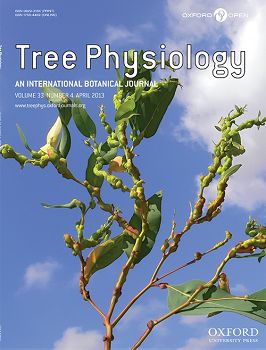Meinzer et al., 2013
Above- and belowground controls on water use by trees of different wood types in an eastern United States deciduous forest
Meinzer, F.C., D.R. Woodruff, D.M. Eissenstat, H.S. Lin, T. Adams, K.A. McCulloh. (2013)
Tree Physiology, Vol 33 (4): 345-356
-
Shale Hills, INVESTIGATOR, COLLABORATOR
-
Shale Hills, INVESTIGATOR
-
IML, Shale Hills, INVESTIGATOR
Abstract
Stomata control tree transpiration by sensing and integrating environmental signals originating in the atmosphere and soil, and co-occurring species may differ in inherent stomatal sensitivity to these above- and belowground signals and in the types of signals to which they respond. Stomatal responsiveness to environmental signals is likely to differ across species having different types of wood (e.g., ring-porous, diffuse-porous and coniferous) because each wood type differs in the structure, size and spatial distribution of its xylem conduits as well as in the scaling of hydraulic properties with stem diameter. The objective of this study was to evaluate the impact of variation in soil water availability and atmospheric evaporative demand on stomatal regulation of transpiration in seven co-occurring temperate deciduous forest species representing three wood types. We measured whole-tree sap flux and soil and atmospheric variables in a mixed deciduous forest in central Pennsylvania over the course of a growing season characterized by severe drought and large fluctuations in atmospheric vapor pressure deficit (D). The relative sensitivity of sap flux to soil drying was ~2.2–2.3 times greater in the diffuse-porous and coniferous species than in the ring-porous species. Stomata of the ring-porous oaks were only about half as responsive to increased D as those of trees of the other two wood types. These differences in responsiveness to changes in the belowand aboveground environment implied that regulation of leaf water potential in the ring-porous oaks was less stringent than that in the diffuse-porous angiosperms or the conifers. The results suggest that increases in the frequency or intensity of summer droughts in the study region could have multiple consequences for forest function, including altered successional time courses or climax species composition and cumulative effects on whole-tree architecture, resulting in a structural and physiological legacy that would restrict the ability of trees to respond rapidly to more favorable growth conditions.
Citation
Meinzer, F.C., D.R. Woodruff, D.M. Eissenstat, H.S. Lin, T. Adams, K.A. McCulloh. (2013): Above- and belowground controls on water use by trees of different wood types in an eastern United States deciduous forest. Tree Physiology, Vol 33 (4): 345-356. DOI: 10.1093/treephys/tpt012
 This Paper/Book acknowledges NSF CZO grant support.
This Paper/Book acknowledges NSF CZO grant support.
Associated Data
Shale Hills - Vegetation - Tree Survey (2008-2012)
3 components •
Susquehanna Shale Hills Critical Zone Observatory •
Biology / Ecology •
Eissenstat, David M.; Kaye, Margot
Explore Further




